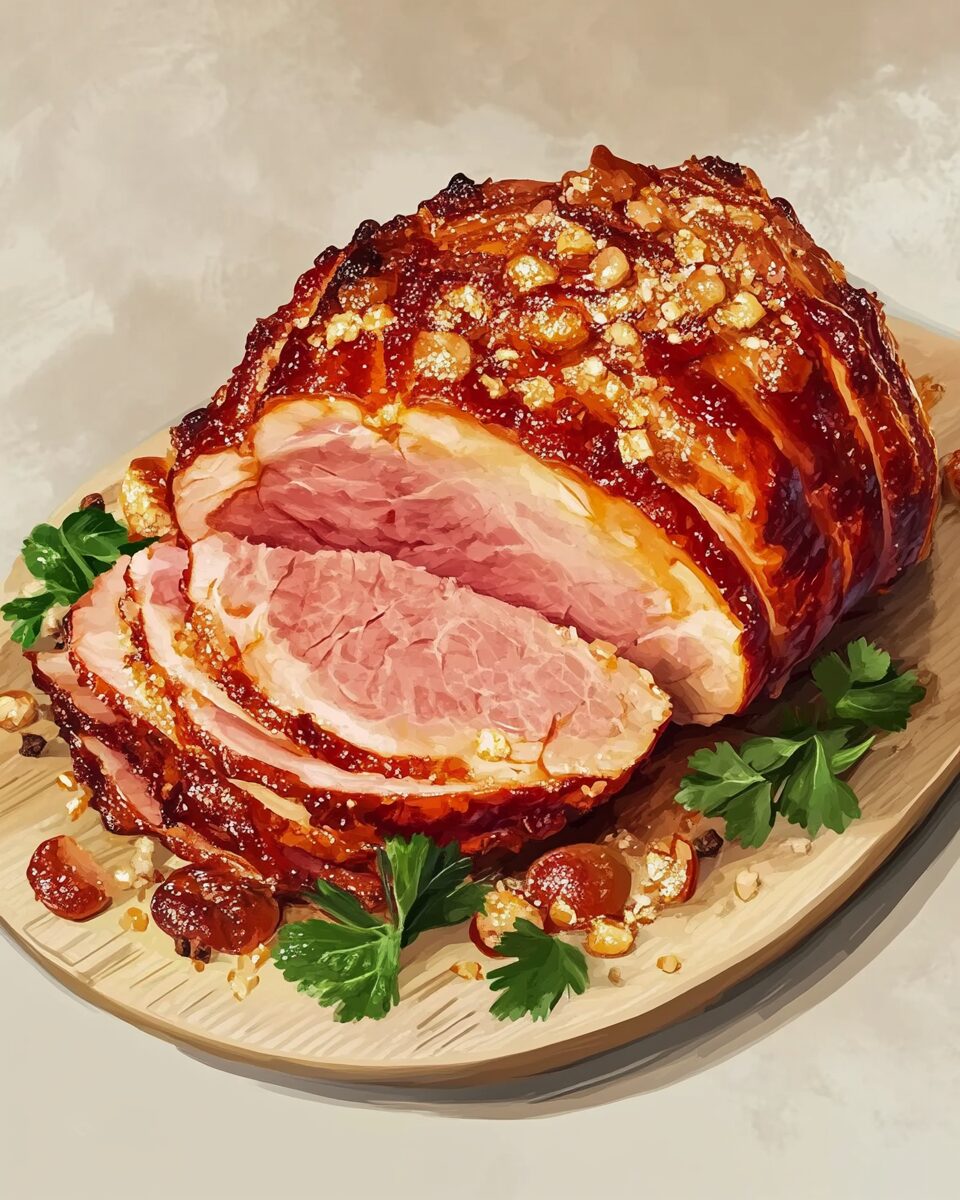This baked ham brings a rich combination of flavors to the holiday table, with its fragrant cloves and a sweet brown sugar glaze that creates a beautiful caramelized crust. It’s an ideal main dish for gatherings, combining simplicity with elegance and filling your home with a cozy aroma.
Perfect for family celebrations, this ham is easy to prepare and only requires a few ingredients. It pairs wonderfully with classic sides like scalloped potatoes, green beans, or a fresh salad. Whether it’s Easter, Christmas, or a cozy Sunday dinner, this baked ham is sure to become a beloved staple in your recipe collection.
Full Recipe:
- 12-pound bone-in ham (rump portion)
- Whole cloves, as desired
- 1 cup brown sugar
- 1 cup water (for the roasting pan)
Directions:
- Preheat oven to 350°F (175°C).
- Place the ham, fat side up, in a roasting pan. Insert whole cloves into the top of the ham at 1-inch intervals.
- Pat the brown sugar all over the surface of the ham, pressing it in to adhere.
- Pour the water into the bottom of the roasting pan, covering the bottom with about an inch of water.
- Cover the ham loosely with foil and bake in the preheated oven for approximately 4.5 to 5 hours, basting occasionally, until an instant-read thermometer reads 160°F when inserted into the center of the ham (avoiding the bone).
- Let the ham rest for 10-15 minutes before slicing.
Prep Time: 10 minutes | Cooking Time: 4 hours 30 minutes | Total Time: 4 hours 40 minutes
Kcal: 350 kcal (approx. per serving) | Servings: 16 servings
The Baked Ham: A Timeless Celebration Dish
Few dishes evoke the warmth and festivity of special gatherings like a beautifully baked ham. Its origins, popularity across cultures, and the nuances of its preparation make it a centerpiece worthy of any holiday table. With its glistening, caramelized exterior and aromatic spices, baked ham carries a tradition of celebration, family togetherness, and timeless flavor.
Historical Background of Baked Ham
Ham has been a part of culinary history for centuries. The tradition of curing pork dates back to ancient times when it was a practical method for preserving meat. Hams were often salted, smoked, or cured, making them last longer, especially in colder climates where refrigeration was unavailable. In Europe, ham held a special place in feasts and holidays. From German Black Forest ham to Italian prosciutto, cured pork became associated with celebration and shared meals.
Baking a ham, particularly in the United States, became a popular holiday tradition, with recipes evolving to include sweet glazes, spices, and unique roasting techniques. Many families now consider a baked ham an essential feature of festive occasions like Christmas, Easter, and Thanksgiving, as it provides not only a delicious main course but also a sense of continuity and nostalgia.
The Appeal of Baked Ham for Holidays
One of the main reasons baked ham is beloved during holiday seasons is its versatility and ease of preparation. A ham can feed a large gathering, and once in the oven, it requires minimal supervision compared to other roasted meats. The aroma of cloves, brown sugar, and ham roasting fills the home with warmth, enhancing the celebratory atmosphere. It’s also a dish that can be served hot, warm, or even cold, allowing hosts flexibility when serving guests.
Baked ham’s flavor profile balances the natural saltiness of the meat with the sweetness of the glaze, creating a delightful contrast. Ingredients like brown sugar, honey, or maple syrup caramelize on the ham’s surface, creating a flavorful crust that complements the savory interior. Whole cloves add warmth and a hint of spice, while optional ingredients like pineapple rings or cherries can add a fruity, festive touch.
Choosing the Right Ham for Baking
When selecting a ham for baking, there are several options to consider. The most common choice for this recipe is a bone-in ham, specifically the rump portion, as it retains moisture during cooking and enhances the overall flavor. Bone-in hams are also visually appealing when presented whole at the table.
Other choices include:
- Whole Ham vs. Half Ham: Whole hams are ideal for large gatherings, while a half ham works well for smaller groups. The “shank” portion has a meatier flavor, while the “butt” portion tends to be fattier and juicier.
- Smoked vs. Unsweetened: Some hams come pre-smoked or with a light seasoning. Smoked ham adds depth to the flavor profile, whereas a simple, unsweetened ham allows the glaze to take center stage.
Glazing the Ham: Brown Sugar and Clove Pairing
The glaze is a defining feature of a baked ham, adding both flavor and visual appeal. Brown sugar and cloves are popular choices due to their rich, warm flavors, which meld beautifully with the ham’s natural taste. Brown sugar melts and caramelizes as it bakes, creating a slightly crisp coating that contrasts with the tender meat beneath. The cloves punctuate the sweetness with a subtle warmth that enhances the aroma and depth of the dish.
Some families incorporate other ingredients into the glaze for a unique twist. Options include:
- Honey or Maple Syrup: These add a touch of natural sweetness that complements brown sugar.
- Mustard or Vinegar: For a bit of tanginess, Dijon mustard or a splash of apple cider vinegar adds a layer of complexity.
- Spices: Nutmeg, cinnamon, or even a touch of allspice can infuse the glaze with seasonal warmth.
Cooking Tips for Perfect Results
To achieve the perfect baked ham, consider a few essential tips that make a noticeable difference in flavor and presentation:
- Slow and Low Cooking: Baked ham benefits from a low-temperature, slow-cooking approach. Baking it at 350°F allows the glaze to caramelize gradually while ensuring the ham heats evenly, keeping it tender and moist.
- Foil Covering: Covering the ham loosely with foil during the first few hours of baking retains moisture, preventing the meat from drying out. Removing the foil for the last 30-40 minutes allows the glaze to become beautifully caramelized.
- Basting Regularly: Every hour or so, baste the ham with the pan juices. This adds moisture and enhances the glaze’s flavor, coating the ham more evenly.
- Checking Doneness: An instant-read thermometer is an essential tool here. When inserted into the center of the ham (but not touching the bone), it should read at least 160°F. This ensures the ham is thoroughly heated without overcooking.
Serving Suggestions: Side Dishes and Pairings
Baked ham is a versatile dish that pairs well with a variety of sides, allowing you to create a memorable and satisfying meal. Traditional sides include:
- Scalloped Potatoes: The creamy texture and mild flavor of scalloped potatoes perfectly balance the savory sweetness of the ham.
- Roasted Vegetables: Root vegetables like carrots, parsnips, and potatoes roasted with a bit of olive oil and herbs add an earthy, complementary taste.
- Green Bean Casserole or Sautéed Green Beans: These classic sides add freshness and a vibrant green to the plate, balancing the richness of the ham.
- Fruit-Based Sides: A fresh apple or cranberry salad provides a tart contrast, while pineapple rings or applesauce add an additional layer of sweetness that ties into the glaze’s flavors.
Wine is another welcome addition to a baked ham dinner. Consider light and fruity options, such as a Riesling or a sparkling rosé, which bring out the sweet and savory notes of the ham.
Storage Tips for Leftovers
One of the many advantages of baked ham is its potential for delicious leftovers. Stored in an airtight container, baked ham can last up to three days in the refrigerator. It’s also a great candidate for freezing—simply wrap leftover slices in plastic wrap and foil for up to two months. Leftover ham is incredibly versatile, lending itself to various dishes such as sandwiches, quiches, and pasta bakes.
Creative Ways to Use Leftover Baked Ham
- Ham and Cheese Sandwiches: A classic option that’s perfect for lunch the day after.
- Quiche Lorraine: A savory pie featuring ham, eggs, and cheese makes for a wonderful brunch dish.
- Ham and Bean Soup: Ideal for a cozy evening, this soup uses ham as the primary flavor, with beans and vegetables for substance.
- Ham and Potato Breakfast Hash: A hearty breakfast option that combines diced ham, potatoes, and onions.
Conclusion: Why Baked Ham Remains a Festive Staple
Baked ham endures as a holiday favorite for its rich flavors, ease of preparation, and the way it brings people together. Its sweet and savory glaze, tender meat, and appealing presentation make it a showstopping centerpiece. Perfect for gatherings large or small, baked ham brings a sense of warmth and tradition to the table, linking past celebrations with those yet to come.
Whether enjoyed fresh from the oven or as leftovers, baked ham is a dish that combines practicality with culinary delight, creating memories that last long after the meal has ended. For any host, it’s a go-to option that embodies the joy of cooking, the art of sharing, and the pleasure of good food enjoyed in the company of loved ones.






